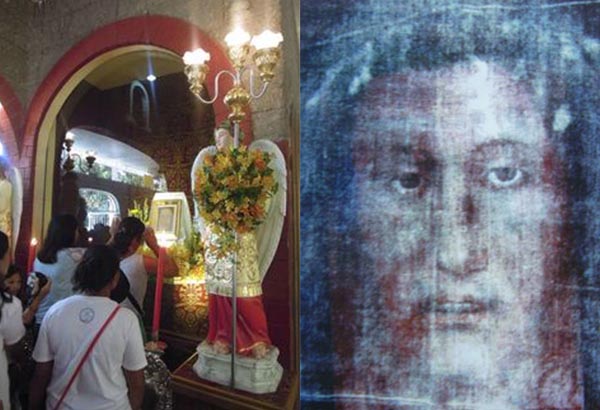Grotto with Jesus’ burial cloth replica draws pilgrims to Nueva Ecija

Bus loads of pilgrims (left) show their devotion to the replica of Christ’s burial veil (right) in Nueva Ecija. Photos from Sanctuary of Holy Face Nampicuan website.
MANILA, Philippines — The Sanctuary of the Holy Veil of Manoppello in Nueva Ecija will be declared a shrine by the Catholic Church on December 8, Feast of the Immaculate Conception.
The grotto holding the replica of Jesus Christ’s burial veil is now a local pilgrimage site that reportedly draws 30 to 40 bus loads of pilgrims at a time.
In 1963, Roman Catholic saint Padre Pio said that Christ’s burial veil or Holy Veil of Manoppello was “the greatest miracle in our possession.”
Also known as the “Veronica,” from the Latin words "vero" (meaning “true”) and "eikon" (meaning “image”), the veil is not the cloth that a woman named Veronica used to wipe the face of Jesus on his way to the cross; rather, it is the cloth that was put on the face of the dead Jesus when he was buried, in accordance with Jewish tradition. It has been described in length in the Bible’s Gospel of John chapter 20, verses one to nine.
The veil is 17 centimeters long and 24 centimeters wide, and made of rare, sheer “sea silk” fiber from mollusk called “byssus,” usually found in the tombs of Egyptian pharaohs. The most striking thing about the veil is its transparency. The image remains perfectly visible from either side, yet under certain light, the image disappears. Scientific tests under ultraviolet light and under the microscope show no paint pigments. This is why it has been referred to as “acheiropoietos,” meaning “not made by the hand of man.”
In 1978, when Sister Blandina Schloemer, who spent 20 years of her life studying the veil, superimposed the Countenance from the Turin Shroud with the Countenance of Manoppello, she found a perfect match. The negative of the dead Christ was fixed on the Turin Shroud, while the positive of the resurrected Christ was imprinted on the veil.
In a 1999 press conference in Rome, Fr. Heinrich Pfeiffer, Jesuit professor of the Gregorian University, announced that the veil in Manoppello is none other than the historic and legendary Veronica. In 2005, German historian/journalist Paul Badde wrote his book, “The Face of God,” which documented his lifelong research on the relic in Manoppello, and sent it to Pope Benedict XVI. On Sept. 1, 2006, Pope Benedict visited the shrine and proclaimed this year as the Year of the Great Jubilee of the Divine Countenance Sanctuary in Manoppello.
On September 16, 2014, Bishop Roberto Mallari of Nueva Ecija, in the presence of Archbishop Florentino Lavarias of Pampanga and Bishop Florentino Cinense of Tarlac, led by Immaculate Conception Parish Priest Fr. Christian Magtalas and Fr. Carmine Cucinelli, Rector of the Basilica of the Holy Face of Manoppello, and benefactors the Alzate and Gallego families, enthroned the Sudarium (an exact replica gifted by the Basilica di Volto Santo in Manoppello), honored as the burial cloth of Christ which bears the holy face of the risen Jesus.
In his homily, Bishop Mallari said, “Why...in this poor parish...of Nampicuan? Why not in the beautiful cathedrals and basilicas around the Philippines? Why the Philippines?...the Episcopal Motto of Pope Francis is: Miserando Atque Eligendo, meaning Lowly and yet Chosen...the summary of the Magnificat (Luke 1:46-55)....Each one of you is invited through....our Blessed Mother Mary, the Immaculate Conception to see and know Jesus by gazing at the face of her son.”
Coinciding with the declaration of the Sanctuary of the Holy Veil of Manoppello in Nueva Ecija as a shrine is the opening of HOPE (House of Prayer and Evangelization) and heritage museum, a 1930s "hacienda" house that was donated by Antonio Ongsiaco Alzate to the Catholic Church, which restored the house to make it HOPE.
WATCH: History of the House of Prayer and Evangelization
YouTube/Manuel Gallego
Visitors and pilgrims are welcome to visit the soon-to-be shrine, house of prayer and heritage museum by the Immaculate Conception Church of Nampicuan, Nueva Ecija, Philippines.
For more information, visit http://www.holyfacenampicuan.com/.



















